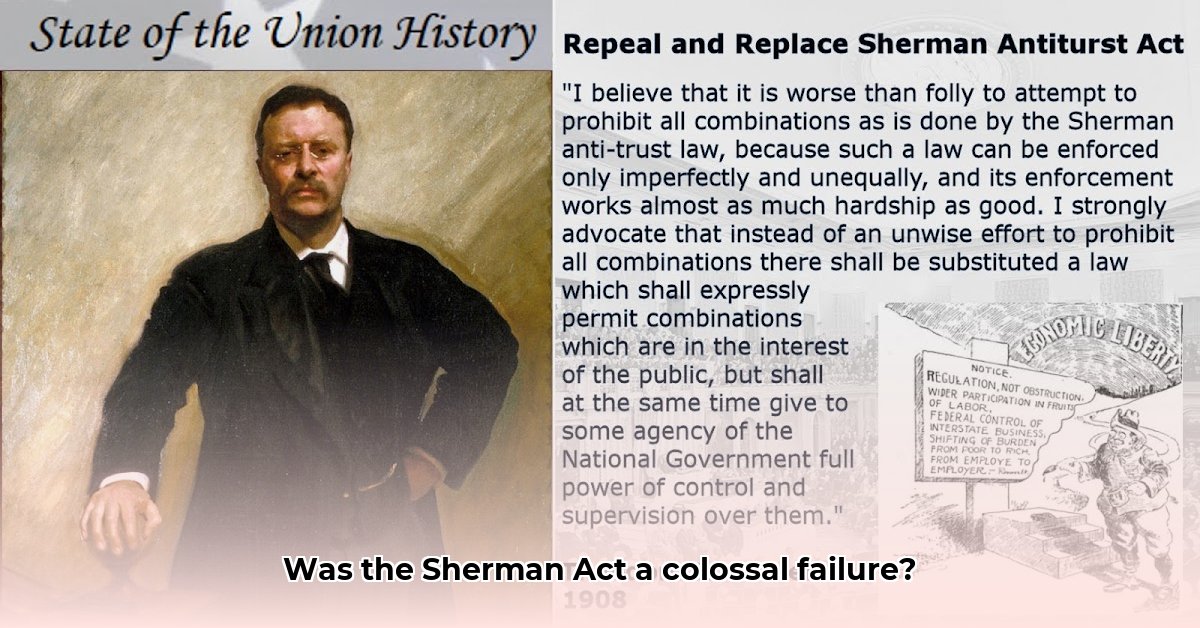
What Were the Drawbacks of the Sherman Antitrust Act?
The Sherman Antitrust Act of 1890, while a landmark piece of legislation aiming to prevent monopolies and promote competition, suffered from significant drawbacks that limited its effectiveness throughout the early 20th century. Its shortcomings stemmed from vaguely defined language, inconsistent enforcement, and the complex interplay of economic and political forces. Did it truly succeed in its ambitious goals? A closer examination reveals a more nuanced picture.
The Peril of Vague Language: Defining "Restraint of Trade"
A primary weakness of the Sherman Act lay in its imprecise language. Terms like "restraint of trade" and "monopolization" lacked clear legal definitions, leading to protracted legal battles and inconsistent interpretations. This ambiguity provided fertile ground for large corporations to exploit loopholes, delaying or even avoiding prosecution. Was a merger inherently a "restraint of trade," or only when accompanied by explicitly anti-competitive tactics? The Act's vagueness offered little guidance, resulting in uneven enforcement and a lack of clear standards for business conduct. This lack of specificity created an environment where powerful corporations, well-resourced with legal expertise, could find ways around the law's intended restrictions. How could a law aim to promote fair competition when its basic terminology was so open to interpretation?
The Burden of Proof: Demonstrating Intent to Monopolize
Further complicating matters was the need to prove "intent" to monopolize. Simply engaging in anti-competitive behavior wasn't enough; the government had to demonstrate a deliberate attempt to eliminate competition. This high burden of proof frequently hampered prosecutions. Corporations could plausibly argue that their actions were legitimate business strategies rather than monopolistic schemes, leaving prosecutors struggling to prove malicious intent. This requirement created a formidable legal hurdle for those seeking to enforce the Act. The question remains: How could the government effectively combat the formation of monopolies when proving the underlying intent presented such a challenge?
Navigating Economic and Political Realities: A Shifting Landscape
The Act's implementation occurred against a backdrop of rapid economic change, with the government struggling to fully understand the intricacies of modern markets. Mergers, while sometimes anti-competitive, could also lead to increased efficiency and economies of scale. Distinguishing between beneficial consolidation and harmful monopolization proved exceedingly difficult. Moreover, powerful business interests wielded considerable political influence, often successfully lobbying to weaken or circumvent the Act's enforcement. This interplay between economic realities and political maneuvering significantly hampered the Act's potential to effectively curb monopolistic practices. Did the Act stand a chance against such powerful opposition?
Uneven Application and Limited Scope: A Patchwork of Outcomes
The Sherman Act's effectiveness varied widely across different sectors. Some industries witnessed meaningful reductions in monopolistic power, while others remained largely unaffected. This inconsistency exposed fundamental flaws in the law's design, underscoring its inability to adapt to the swiftly changing dynamics of American business. Furthermore, the Act failed to explicitly address practices such as price-fixing or predatory pricing, further limiting its ability to directly tackle specific anti-competitive behaviors. How could such a broad and vaguely worded law hope to be effective in such a dynamic environment?
How Effective Were Progressive Era Antitrust Laws in Curbing Monopolies?
The Progressive Era saw various attempts to regulate monopolies, with the Sherman Antitrust Act serving as the foundation. However, its limitations, as discussed above, led to mixed results. The vague language and difficulties in proving intent often hampered effective enforcement. The later introduction of the “rule of reason,” while providing some clarity, also introduced new challenges and ambiguities. While landmark cases like the breakup of Standard Oil and American Tobacco demonstrated the Act’s potential, these were exceptions rather than the rule. Many powerful monopolies persisted, continuing to exert significant influence over the American economy. The question of the true effectiveness of the Progressive Era's antitrust efforts remains a subject of ongoing debate among historians and legal scholars. The limitations of the Sherman Act, and the necessary adjustments made by later legislation, highlight the enduring challenges of effectively regulating powerful economic actors.